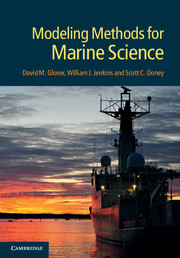Book contents
- Frontmatter
- Contents
- Preface
- 1 Resources, MATLAB primer, and introduction to linear algebra
- 2 Measurement theory, probability distributions, error propagation and analysis
- 3 Least squares and regression techniques, goodness of fit and tests, and nonlinear least squares techniques
- 4 Principal component and factor analysis
- 5 Sequence analysis I: uniform series, cross- and autocorrelation, and Fourier transforms
- 6 Sequence analysis II: optimal filtering and spectral analysis
- 7 Gridding, objective mapping, and kriging
- 8 Integration of ODEs and 0D (box) models
- 9 A model building tutorial
- 10 Model analysis and optimization
- 11 Advection–diffusion equations and turbulence
- 12 Finite difference techniques
- 13 Open ocean 1D advection–diffusion models
- 14 One-dimensional models in sedimentary systems
- 15 Upper ocean 1D seasonal models
- 16 Two-dimensional gyre models
- 17 Three-dimensional general circulation models (GCMs)
- 18 Inverse methods and assimilation techniques
- 19 Scientific visualization
- Appendix A Hints and tricks
- References
- Index
12 - Finite difference techniques
Published online by Cambridge University Press: 05 June 2012
- Frontmatter
- Contents
- Preface
- 1 Resources, MATLAB primer, and introduction to linear algebra
- 2 Measurement theory, probability distributions, error propagation and analysis
- 3 Least squares and regression techniques, goodness of fit and tests, and nonlinear least squares techniques
- 4 Principal component and factor analysis
- 5 Sequence analysis I: uniform series, cross- and autocorrelation, and Fourier transforms
- 6 Sequence analysis II: optimal filtering and spectral analysis
- 7 Gridding, objective mapping, and kriging
- 8 Integration of ODEs and 0D (box) models
- 9 A model building tutorial
- 10 Model analysis and optimization
- 11 Advection–diffusion equations and turbulence
- 12 Finite difference techniques
- 13 Open ocean 1D advection–diffusion models
- 14 One-dimensional models in sedimentary systems
- 15 Upper ocean 1D seasonal models
- 16 Two-dimensional gyre models
- 17 Three-dimensional general circulation models (GCMs)
- 18 Inverse methods and assimilation techniques
- 19 Scientific visualization
- Appendix A Hints and tricks
- References
- Index
Summary
It is better to take many small steps in the right direction than to make a great leap forward only to stumble backward.
Ancient Chinese ProverbEverything should be made as simple as possible, but not simpler.
Albert EinsteinBasic principles
Constructing numerical models of marine systems usually involves setting up a series of partial differential equations, specifying boundary conditions and then “running the model”. Your purpose may be to establish the value of parameters (e.g. rates of reaction or the magnitude of some property), estimate fluxes, or make some prediction about the future state of the system. Although you can sometimes choose a physical problem that is simple enough to be modeled with analytic solutions (an example would be Munk's 1966 “Abyssal recipes” model; Chapter 13), more often than not you will encounter situations where the processes or the geometry of the system are too complex to allow analytic solutions.
Don't get us wrong; analytic solutions are nice. They can often provide you with a nice conceptual, intuitive feel for how the system responds, especially in an asymptotic sense. However, for realistic geometries, you will find that the few analytical solutions provided in many books are infinite series solutions. Be very, very careful when dealing with those series solutions. Pay particular attention to the assumptions made in deriving the solutions, to the conditions under which they ought to be applied, and especially to convergence issues.
- Type
- Chapter
- Information
- Modeling Methods for Marine Science , pp. 299 - 331Publisher: Cambridge University PressPrint publication year: 2011



